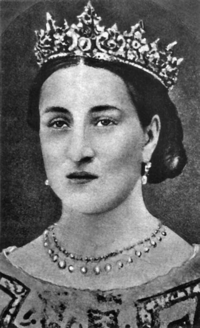Fatma Sultan (daughter of Abdülmecid I)
| Fatma Sultan | |
|---|---|
 | |
| Born |
1 November 1840 Istanbul, Ottoman Empire |
| Died |
29 August 1884 (aged 43) Istanbul, Ottoman Empire |
| Burial | New Mosque, Istanbul |
| Spouse |
Ali Galip Pasha Nuri Pasha |
| Issue |
Cemile Sultan Sultanzade Mehmed Fuad Bey Emine Lütfiye Sultan |
| Dynasty | Ottoman |
| Father | Abdulmejid I |
| Mother | Gülcemal Kadın |
| Religion | Sunni Islam |
Fatma Sultan (Ottoman Turkish: فاطمہ سلطان; 1 November 1840 – 29 August 1884) was an Ottoman princess, the daughter of Sultan Abdulmejid I (reign 1839 - 1861) and sister of Sultan Mehmed V (reign 1909 - 1918) of the Ottoman Empire.
Early life
Fatma Sultan was on 1 November 1840 at the Beşiktaş Palace. Her mother was Gülcemal Kadın. She second child and eldest daughter born to her father, and the eldest daughter born to her mother, hence the full sister of her younger siblings Refia Sultan and Sultan Mehmed V. Upon the death of her mother in 1851, she and her siblings were adopted by Abdulmejid's first wife, Servetseza Kadın.[1][2]
Marriages
Ali Galib Pasha
When Fatma Sultan came of age, the sons of some of the most exalted personages aspired to the hand of the young princess. Mustafa Reshid Pasha and more especially his wife Adile Hanım, who was excessively proud, were particularly anxious that their son, Ali Galib Pasha, should become the Sultan's son-in-law. The other ministers wished to please the Grand vizier, and tried to induce their master to give the hand of the princess to the son of their colleague. After much pressing, the Sultan consented to the proposed union. However, Reshid Pasha feared the if this marriage took place while he was grand vizier, the people would murmur. The marriage took place on 2 August 1854 which lasted seven days and was consummated on 10 August.
Abdulmejid first purchased Mustafa Reşid Paşa's palace and waterfront house in Baltalimani at a cost of 250 000 gold liras. He then gave freehold possession of these estates to his daughter Fatma Sultan, leaving the Pasha with a vast fortune to pay for the wedding expenses. Ali Galip Bey was appointed to Pasha's rank and made a member of the Meclis-i Vâlâ (Supreme Court).
The wedding of Fatma Sultan coincided with the most fervent period of the Crimean War. The wedding took place on 7 August 1854 at the Old Çırağan Palace and lasted for seven days. The bridal procession of Fatma Sultan left this palace, and traveled with "pomp and circumstance" partly by land and partly by sea, conveying the bride to Baltalimam Palace. The combined excitement of war and wedding mesmerized the city for days. The many foreigners in Istanbul were also fascinated by the traditional, and to them exotic, ceremony. The meadows in Baltalimani Bay were prepared for festivities and entertainments, and colourful embroidered pavilions erected for the guests. The meadows were thronged with elegantly dressed men and women who arrived in royal coaches, koçu (large carriages) and richly furbished caiques. Wedding banquets were held day after day, as dance troupes and clowns entertained the crowds. Reşid Pasha Palace, which had been converted into suites for the sultan's retinue, and the avenue of trees between the two buildings formed the setting of this magnificent wedding.
The next year she gave birth to a daughter, Cemile Sultan, who died in infancy.
Nuri Pasha
After the death of Ali Galib Pasha in 1858 she married, Nuri Pasha on 24 March 1859. Two children, Sultanzade Mehmed Fuad Bey and Emine Lütfiye Sultan, were born of this marriage. Both of her children died young. Following the dubious conviction and exile to Arabia of her second husband for complicity in the death of Sultan Abdülaziz, Fatma withdrew to her shore side villa.
Death
She died on 29 August 1884 and is buried in the mausoleum of Sultan Murad V at the New Mosque, Istanbul.[3][4]
References
- ↑ Uluçay 2011, p. 218.
- ↑ Sakaoğlu 2009, p. 604-5.
- ↑ Uluçay 2011, p. 219-20.
- ↑ Sakaoğlu 2009, p. 613.
Sources
- Mustafa Çağatay Uluçay (2011). Padişahların kadınları ve kızları. Ankara, Ötüken.
- The Concubine, the Princess, and the Teacher: Voices from the Ottoman Harem. University of Texas Press. 2010. ISBN 978-0-292-78335-5.
- Sakaoğlu, Necdet (2008). Bu mülkün kadın sultanları: Vâlide sultanlar, hâtunlar, hasekiler, kadınefendiler, sultanefendiler. Oğlak Yayıncılık. ISBN 978-9-753-29623-6.
